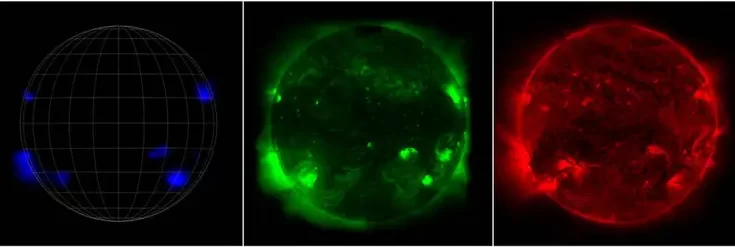We are unable to see all the light our nearest star emits, even on a sunny day. A new image displays some of this hidden light, including high-energy X-rays emitted by the hottest material in the Sun’s atmosphere, as observed by NASA’s Nuclear Spectroscopic Telescope Array (NuSTAR). While the observatory typically studies objects outside our solar system – like massive black holes and collapsed stars – it has also provided astronomers with insights about our Sun.
In this composite image (left), blue NuSTAR data is overlaid with observations by the X-ray Telescope on the Japanese Aerospace Exploration Agency’s Hinode mission, represented as green, and the Atmospheric Imaging Assembly on NASA’s Solar Dynamics Observatory, represented as red. The observatory’s view of the Sun is actually a mosaic of 25 images, taken in June 2022.
In contrast to NuSTAR, Hinode’s XRT detects low-energy X-rays, and SDO’s AIA detects ultraviolet light – wavelengths that are emitted across the entire face of the Sun.
NuSTAR’s view could help scientists solve one of the biggest mysteries about our nearest star: why the Sun’s outer atmosphere, called the corona, reaches more than a million degrees – at least 100 times hotter than its surface. This has puzzled scientists because the Sun’s heat originates in its core and travels outward. It’s as if the air around a fire were 100 times hotter than the flames. The source of the corona’s heat could be small eruptions in the Sun’s atmosphere called nanoflares.
Although individual nanoflares are too faint to observe amid the Sun’s blazing light, NuSTAR can detect light from the high-temperature material thought to be produced when a large number of nanoflares occur close to one another. This ability enables physicists to investigate how frequently nanoflares occur and how they release energy. The observations used in these images coincided with the 12th close approach to the Sun, or perihelion, by NASA’s Parker Solar Probe, which is flying closer to the our star than any other spacecraft in history.
NuSTAR launched on June 13, 2012. A Small Explorer mission led by Caltech in Pasadena, California, and managed by JPL for NASA’s Science Mission Directorate in Washington, it was developed in partnership with the Danish Technical University (DTU) and the Italian Space Agency (ASI). The telescope optics were built by Columbia University, NASA’s Goddard Space Flight Center in Greenbelt, Maryland, and DTU. The spacecraft was built by Orbital Sciences Corp. in Dulles, Virginia.




